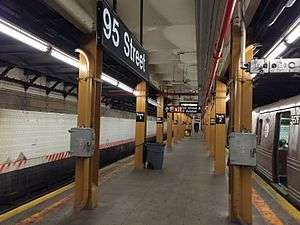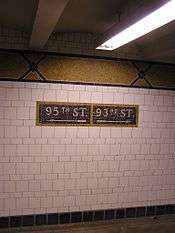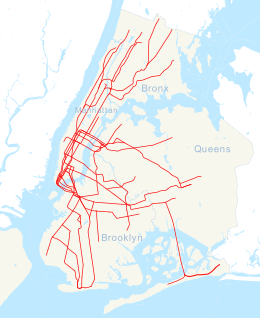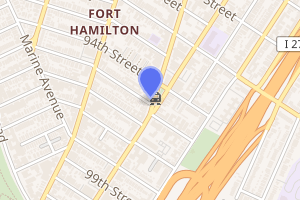Bay Ridge–95th Street station
Bay Ridge–95th Street (originally 95th Street–Fort Hamilton) is the southern terminal station on the BMT Fourth Avenue Line of the New York City Subway. Despite the name, the station is located in the neighborhood of Fort Hamilton (as its original name implied) at the intersection of 95th Street and Fourth Avenue in southwestern Brooklyn. It is served by the R train at all times.
Bay Ridge–95 Street | |||||||
|---|---|---|---|---|---|---|---|
 Station platform. | |||||||
| Station statistics | |||||||
| Address | 95th Street & Fourth Avenue Brooklyn, NY 11209[1] | ||||||
| Borough | Brooklyn | ||||||
| Locale | Fort Hamilton | ||||||
| Coordinates | 40°36′58.2″N 74°1′52.4″W | ||||||
| Division | B (BMT) | ||||||
| Line | BMT Fourth Avenue Line | ||||||
| Services | R | ||||||
| Transit connections | |||||||
| Structure | Underground | ||||||
| Platforms | 1 island platform | ||||||
| Tracks | 2 | ||||||
| Other information | |||||||
| Opened | October 31, 1925[3] | ||||||
| Station code | 039[4] | ||||||
| Accessible | not ADA-accessible; accessibility planned | ||||||
| Opposite-direction transfer available | N/A | ||||||
| Former/other names | 95th Street–Fort Hamilton | ||||||
| Traffic | |||||||
| Passengers (2019) | 1,743,441[5] | ||||||
| Rank | 269 out of 424[5] | ||||||
| Station succession | |||||||
| Next north | 86th Street: R | ||||||
| Next south | (Terminal): R | ||||||
| |||||||
| |||||||
| |||||||
The station was first planned in 1922 as the first part of an extension to Staten Island through a tunnel under the Narrows. Construction began on December 17, 1923, after the construction contractor submitted, withdrew, and resubmitted its bid. The station opened on October 31, 1925, but the Staten Island extension was never built due to various funding disputes. The platform was lengthened in the 1960s.
History
_03.jpg)
Construction and opening
On August 25, 1922, the Transit Commission directed its chief engineer, Robert Ridgeway, to plan an extension of the Fourth Avenue Line from 87th Street to Fort Hamilton. Initially, multiple stations along the extension were considered. This extension was to be the first part of an extension to Staten Island through a tunnel under The Narrows.[6] On September 12, 1922, a meeting was held by the Transit Commission to determine whether a stop at 91st Street should be included as part of the planned extension. Ultimately, no station was built at 91st Street.[7] At the meeting it was decided that money for an additional station in between 86th Street and the new terminal at 95th Street would be better spent on an extensive terminal with entrances at 93rd, 94th, and 95th Streets.[8] Other extensions were also planned in 1922: a branch of the line running via 86th Street to 18th Avenue to connect with the New Utrecht Line to Coney Island, Route 19, and the future subway under Tenth Avenue, as well as a branch of the line at 67th Street heading to Staten Island, Route 20.[9]
On December 28, 1922, the Transit Commission announced that it had awarded the contract for the construction of a half-mile extension of the Fourth Avenue Line, Contract 11B,[10] to T. A. Gillespie Company for $1.5 million (equivalent to $23 million in 2019). However, as the Board of Estimate failed to take action upon it, the contractor withdrew its bid on March 7, 1923.[11] The Transit Commission blamed the Board of Estimate for delays in the awarding of the contract; the Commission said that the city would suffer a substantial loss due to increased construction costs, and because the contract that was given was "highly advantageous to the city."[12] As part of Contract 11B, the extension was built with two tracks, with the exception of a short three-track stretch just north of the terminal at 95th Street.[13] The extension was to be built with a provision to extend the line to Staten Island.[14] As a result of a motion made by Commissioner LeRoy Harkness in front of the Transit Commission, the contract was set to be put back up for bid.[15] On November 2, 1923, the Board of Estimate approved the contract for the line with T. A. Gillespie Company, the same contractor that had bid on the project earlier, but withdrew. The Transit Commission, due to the delay of the project, gave orders on November 3 to speed up the completion of the project.[16] Construction began on December 17, 1923.[17][18] The final extension to 95th Street, Route 18, opened on October 31, 1925,[3][17] with the first train leaving at 2 p.m.[3]
Platform extension
In the 1960s, the New York City Transit Authority (NYCTA) started a project to lengthen station platforms on its lines in Southern Brooklyn to 615 feet (187 m) to accommodate 10-car trains.[19] On July 14, 1967, the NYCTA awarded a contract to conduct test borings at eleven stations on the Fourth Avenue Line, including 95th Street, to W. M. Walsh Corporation for $6,585 (equivalent to $50,492 in 2019) in preparation of the construction of platform extensions.[20] The NYCTA issued an invitation for bids on the project to extend the platforms at stations along the Fourth Avenue Line between 45th Street and this station on May 3, 1968.[21] However, work had already started on the platform extension project in February. The platform at 95th Street was extended by 85 feet (26 m) to the south.[22]
Station layout
| G | Street level | Exit/entrance |
| M | Mezzanine | Fare control, station agent, MetroCard machines |
| P Platform level |
Track 2 | ← |
| Island platform | ||
| Track 1 | ← | |
This underground station has two tracks and one island platform.[23] The tracks end at bumper blocks at the south end of the platform.[24][25] North of this station, a center layup track forms just north of the diamond crossover, before ending at a bumper block just south of 86th Street station.[24] The R stops here at all times.[26]
The platform has yellow painted I-beam columns and alternate ones have "95 Street" signs on them.[27] Both platform walls have their original mosaic trim line with name tablets reading "95TH STREET" along the entire station except for a small section at the north end, where the platform was extended in 1970.[28] Here, the wall is bare black.[29] The platforms were originally 530 feet (160 m) in length.[23] The station was constructed with a signal tower and dispatcher's office.[23]
Exits

The station has two mezzanines above the platform and tracks. Mosaic directional signs indicate they were originally one full-length mezzanine.[30][31] The closed-off sections are now used for employee-only spaces.[31] The station's larger, full-time mezzanine is at the south end. It has two staircases from the platform, a turnstile bank,[32] a token booth,[33] and two restrooms.[34][35] In addition, two staircases going up to either western corners of Fourth Avenue and 95th Street. A passageway leads to another staircase on the east side of the intersection, built inside an alcove of 9425 Fifth Avenue.[36] The station's other mezzanine is unstaffed, containing one staircase from the platform,[37] high entry/exit turnstiles,[30] and two staircases going up to either southern corners of 93rd Street and Fourth Avenue.[38] Additional exits were planned at 94th Street, but were never built.[39]
Provisions for proposed extensions

The station is built on the west side of Fourth Avenue due to plans for a possible extension of the express tracks south of 59th Street.[40] This station had been built mainly to facilitate the Staten Island Tunnel or the "Narrows Tunnel", which would have necessitated express service, although the tunnel was never constructed.[41][42]
South of this station, there is a false wall at the end of the tracks for a planned extension to 100th or 101st Street[43] and into the never-built Staten Island "Narrows Tunnel", connecting the BMT line with the Staten Island Railway (SIRT) Main Line near its Grasmere station. The station would have also connected with the now-defunct South Beach Branch by disconnecting it from the SIRT main line, with the BMT Fourth Avenue Subway taking over service from the SIRT's Fort Wadsworth station to the Wentworth Avenue terminal. At the time it would have been a very different line had this tunnel been built, with through BMT service from Queensboro Plaza to Wentworth Avenue in Staten Island stopping at this station before proceeding to Staten Island, since this station is also the closest point to Staten Island. There were also plans to construct an underground storage yard here. The SIRT had been electrified in preparation for the tunnel, and had purchased subway cars similar to the AB Standards of the BMT.[44]
The tunnel plan was amended in 1919, moving its location north to Shore Road in Bay Ridge.[45] A groundbreaking ceremony was held by New York City Mayor John Hylan on April 14, 1923 in Bay Ridge[46][47] and in Staten Island on July 19.[48][49] In 1925, however—the year bids from contractors were to be entertained by the city—the project was halted and the project's engineering staff laid off.[48] Officially, the plan was delayed due to lack of funding,[50][51] but Hylan and New York City Board of Transportation (BOT) Chairman John Delaney also wanted to secure freight service for the tunnel.[48][52] These disagreements caused deadlocks between the parties involved.[48]
Later proposals surfaced to connect the station to the Verrazzano-Narrows Bridge, one of the world's longest suspension bridges, which follows the route of the planned tunnel. The bridge was completed in 1964 without provisions for rail traffic.[41][44][53]
References
- "Borough of Brooklyn, New York City". Government of New York City. Retrieved April 16, 2020.
- "Brooklyn Bus Map" (PDF). Metropolitan Transportation Authority. November 2017. Retrieved April 24, 2018.
- "95th St. Subway Extension Opened At 2 P. M. Today". Brooklyn Daily Eagle. October 31, 1925. Retrieved June 29, 2015 – via newspapers.com

- "Station Developers' Information". Metropolitan Transportation Authority. Retrieved June 13, 2017.
- "Facts and Figures: Annual Subway Ridership 2014–2019". Metropolitan Transportation Authority. 2020. Retrieved May 26, 2020.
- "TO EXTEND SUBWAY TO FORT HAMILTON; Transit Commission Orders Plans for Lengthening the Fourth Avenue Line. WOULD AID STATEN ISLAND Ferry Service May Be Established Until Tunnel Route is Selected" (PDF). The New York Times. August 26, 1922. Retrieved May 4, 2017.
- "SUBWAY HEARING TODAY.; Transit Board to Consider Pains for Line to Fort Hamilton" (PDF). The New York Times. September 12, 1922. Retrieved May 4, 2017.
- "LOCATES EXTENSION STATION; Transit Board Decides on 93d-95th St., Brooklyn, Site" (PDF). The New York Times. September 13, 2017. Retrieved May 4, 2017.
- The City Record: Official Journal. September 27, 1922. p. 6471.
- "Public Notices". The Brooklyn Daily Eagle. November 22, 1922. p. 18. Retrieved May 4, 2017.
- "One Way To Get Transit". The Brooklyn Daily Eagle. May 16, 1923. p. 6. Retrieved May 4, 2017.
- "SUBWAY DELAY LAID TO ESTIMATE BOARD; Transit Commission Blames It for Failure to Push Fort Hamil- ton Line". The New York Times. March 8, 1923. ISSN 0362-4331. Retrieved May 4, 2017.
- "$1,485,151 Bid Wins Contract To Build Ft. Hamilton Tube". The Brooklyn Daily Eagle. December 28, 1922. p. 19. Retrieved May 4, 2017.
- "THREE RAPID TRANSIT CONTRACTS ARE LET; They Cover Ft. Hamilton Extension, 14th St.-Eastern Workand 168th St. Elevators" (PDF). The New York Times. December 29, 1922. Retrieved May 4, 2017.
- "To Ask New Subway Bids". The New York Times. September 14, 1923. ISSN 0362-4331. Retrieved May 4, 2017.
- "TO RUSH SUBWAY WORK.; Contractor Ready to Begin Work on Fourth Avenue Extension". The New York Times. November 4, 1923. ISSN 0362-4331. Retrieved May 4, 2017.
- "OPEN SUBWAY LINE TO FORT HAMILTON; Fourth Avenue Extension Put in Service After Wait of Four Years. HALF-MILE COST $2,000.000 Completion Gives Residents Through Trip Without Recourse to Trolley Cars". The New York Times. November 1, 1925. ISSN 0362-4331. Retrieved May 4, 2017.
- Rogoff, David (May 1961). "New York Division ERA Bulletin May 1961". Google Docs. Retrieved May 8, 2017.
- New York City Transit Authority Annual Report For The Year June 30, 1960. New York City Transit Authority. 1960. pp. 16–17.
- Minutes and Proceedings. New York City Transit Authority. 1967. pp. 379–380.
- Engineering News-record. McGraw-Hill. 1968. p. 75.
- Rogoff, Dave (February 1969). "BMT Broadway Subway Platform Extensions" (PDF). New York Division Bulletin. Electric Railroaders' Association. 12 (1): 4.
- "Subway Bids Announced: For 95th Street Terminal, Brooklyn, and Corona Yard" (PDF). The New York Times. March 1, 1925. ISSN 0362-4331. Retrieved June 28, 2015.
- Dougherty, Peter (2006) [2002]. Tracks of the New York City Subway 2006 (3rd ed.). Dougherty. OCLC 49777633 – via Google Books.
- Rosenfeld, Robbie (October 15, 2017). "View of the bumper blocks at the south end of the station". nycsubway.org. Retrieved April 19, 2020.
- "R Subway Timetable, Effective November 17, 2019" (PDF). Metropolitan Transportation Authority. Retrieved January 16, 2020.
- Cox, Jeremiah (June 9, 2009). "Looking down the single, narrow island platform at 95 Street-Bay Ridge". subwaynut.com. Retrieved April 19, 2020.
- Cox, Jeremiah (June 9, 2009). "A close-up of 95 Street written in mosaic into the mosaic trim". subwaynut.com. Retrieved April 19, 2020.
- Cox, Jeremiah (June 9, 2009). "A R46 R train enters 95th Street, approaching the one part of the platform wall that is untiled". subwaynut.com. Retrieved April 19, 2020.
- Cox, Jeremiah (June 9, 2009). "A High Entrance/Exit and a High Exit Turnstile lead out to the exit to 93 Streets". subwaynut.com. Retrieved April 19, 2020.
- Rosenfeld, Robbie (October 15, 2017). "View of mosaic tiling indicating that the station used to have a full-length mezzanine". nycsubway.org. Retrieved April 19, 2020.
- Cox, Jeremiah (June 9, 2009). "The turnstiles and decently sized mezzanine from the 95 Street entrance". subwaynut.com. Retrieved April 19, 2020.
- Rosenfeld, Robbie (October 15, 2017). "View of the 95th Street mezzanine". nycsubway.org. Retrieved April 19, 2020.
- Cox, Jeremiah (June 9, 2009). "The mosaic Men sign and open men's room on the mezzanine level at 95 Street". subwaynut.com. Retrieved April 19, 2020.
- Cox, Jeremiah (June 9, 2009). "The Women's room on the mezzanine level at 95 Street, whose sign says it should be open is locked tight". subwaynut.com. Retrieved April 19, 2020.
- Cox, Jeremiah (June 9, 2009). "An unusual subway entrance to 95 Street with an old mosaic sign leading to a now closed shoes repaired while you wait". subwaynut.com. Retrieved April 19, 2020.
- Cox, Jeremiah (June 9, 2009). "Approaching the single staircase right at the most northern of the platform at 95 Street to the unstaffed exit to 93 Streets". subwaynut.com. Retrieved April 19, 2020.
- "MTA Neighborhood Maps: Bay Ridge" (PDF). mta.info. Metropolitan Transportation Authority. 2015. Retrieved June 29, 2015.
- "Locates Extension Station: Transit Board Decides on 93d-95th St,. Brooklyn, Site" (PDF). The New York Times. September 13, 1922. ISSN 0362-4331. Retrieved June 29, 2015.
- "Brooklyn Subway Extension Plan: Fourth Ave. Line to 86th St., Tunnel to Staten Island, and Eventually a Through Route to Coney Island" (PDF). The New York Times. February 16, 1912. ISSN 0362-4331. Retrieved June 28, 2015.
- "To Extend Subway to Fort Hamilton" (PDF). The New York Times. August 26, 1922. ISSN 0362-4331. Retrieved June 27, 2015.
- "Three Rapid Transit Contracts are Let" (PDF). The New York Times. December 29, 1922. ISSN 0362-4331. Retrieved June 28, 2015.
- "Discuss Subway Work: Fort Hamilton Taxpayers Want 100th Street Extended" (PDF). The New York Times. September 24, 1911. ISSN 0362-4331. Retrieved June 28, 2015.
- Leigh, Irvin; Matus, Paul (January 2002). "State Island Rapid Transit: The Essential History". thethirdrail.net. The Third Rail Online. Archived from the original on May 30, 2015. Retrieved June 27, 2015.
- "To Act This Year on the Richmond Tube: Route Approved in 1912 Still Alive-May Soon Be Adopted Anew or Amended" (PDF). The New York Times. February 13, 1919. ISSN 0362-4331. Retrieved June 27, 2015.
- Niebuhr, Robert E. (November 27, 1964). "They Called The 1923 Narrows Tunnel: 'Hope And A Hole In The Ground'". brooklynrail.net. Home Reporter and Sunset News, Brooklyn Historic Railway Association. Retrieved June 27, 2015.
- "Staten Island Tube Started by Hylan" (PDF). The New York Times. April 15, 1923. ISSN 0362-4331. Retrieved June 27, 2015.
- Raskin, Joseph B. (2013). The Routes Not Taken: A Trip Through New York City's Unbuilt Subway System. New York, New York: Fordham University Press. p. 148. doi:10.5422/fordham/9780823253692.001.0001. ISBN 978-0-82325-369-2.
- "Hylan Swings Pick at Shaft Opening; Formally Starts Work at the Staten Island End of Narrows Tunnel" (PDF). The New York Times. July 20, 1923. Retrieved September 6, 2016.
- Pitanza, Marc (2015). Staten Island Rapid Transit Images of Rail. Arcadia Publishing. ISBN 978-1-4671-2338-9.
- Leigh, Irvin; Matus, Paul (January 2002). "Staten Island Rapid Transit: The Essential History". thethirdrail.net. The Third Rail Online. Retrieved June 27, 2015.
- Young, James C. (May 10, 1925). "Staten Island Waits for Narrows Tunnel" (PDF). The New York Times. ISSN 0362-4331. Retrieved June 27, 2015.
- Martin, Douglas (November 17, 1996). "Subway Planners' Lofty Ambitions Are Buried as Dead-End Curiosities". The New York Times. ISSN 0362-4331. Retrieved June 27, 2015.
External links
| Wikimedia Commons has media related to Bay Ridge – 95th Street (BMT Fourth Avenue Line). |
- nycsubway.org – BMT 4th Avenue Line: 95th Street/Fort Hamilton
- Station Reporter — R Train
- The Subway Nut - Bay Ridge–95th Street Station Pictures
- 95th Street entrance from Google Maps Street View
- Platform from Google Maps Street View



